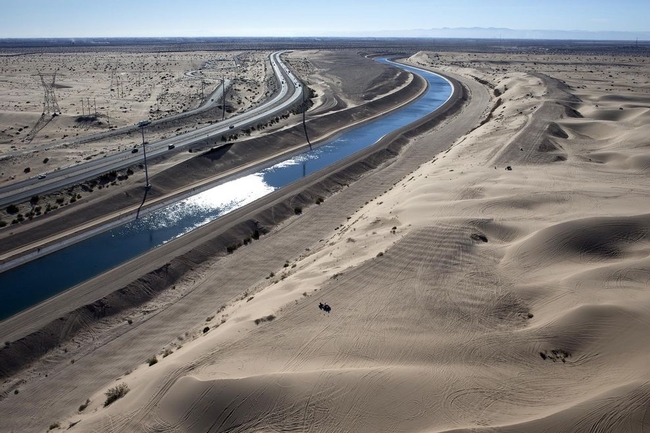For those of you who have followed the controversy about the export of ‘virtual water' in the form of hay exported to other countries – there is a recent article posted in January on the National Geographic Website: “Exporting the Colorado River to Asia, through hay”
Photo: Water conveyed from the Colorado River to the Imperial Valley. Alfalfa hay as well as a plethora of winter vegetables in rotation with alfalfa are grown there. (Mark Henle, National Geographic, photo)
This article follows up on Robert Glennon's October 2012 piece in the Wall Street Journal “Shipping Water to China, Bale by Bale” as well as a blog on this site by yours truly “Is Shipping Hay to China Immoral?”
It is indeed becoming curiouser and curiouser (to quote Alice in Wonderland) that this discussion should focus so one-sidedly on our lowly alfalfa crop. Even the National Geographic article implies that the quantity of ‘water' exported with alfalfa (billions of gallons) is miniscule in relationship to the amount of virtual ‘water' exported for years in other crops (trillions of gallons) ---remember, a trillion is a thousand billion. I haven't done a complete calculation, but it is likely that alfalfa is less than 1% of the total exported ‘water' (if you will) from the US from agriculture.
Yet the focus is on alfalfa. Why not cut off the exports of cotton (by the way, our cotton goes to Indonesia and Bangladesh before it comes back as a t-shirt), wheat, soybeans or corn? Strawberries, rice, citrus, fruits, almonds, apples, canned tomatoes, blueberries or walnuts? Wines or cheese? Beef, chicken, hog, or dairy products? Fresh lettuce, spinach, onions, broccoli and cauliflower ‘exported' to frozen New York or Tokyo from the Imperial Valley? Desert wheat from Imperial grown for pasta made in Italy. The list goes on and on. All of these are exported from irrigated or rain-fed farming regions to the benefit of farmers and consumers in cities, foreign or domestic (and, I should add, to the benefit of the US economy as a whole). These crops account for vastly greater amounts of virtual water than alfalfa hay.
This would tend to support the view that the focus on alfalfa is primarily due to a gut feeling (“utter disbelief”) or lack of appreciation of hay, rather than a careful analysis of the quantities of water, nor the economic impacts involved.
Farmers and extension agronomists are working hard to figure out how to produce crops during this year's severe drought in California, which in the case of alfalfa includes deficit irrigation strategies as suggested in the NatGeo article (see my talk in 2012 on Strategies for Water Use improvements in Alfalfa—see my talk, a video ‘Strategies for the Future of Water-Use Efficient Alfalfa Production Systems: and Larry Schwankl's talks: "Irrigation Water Management Options for Alfalfa" and Irrigating Alfalfa during a Drought. We're going to need every trick in the book including technology and management to deal with this year's severe drought for all crops. Luckily, we CAN significantly deficit irrigate alfalfa successfully, whereas it's much more difficult with fruiting and seed-producing plants.
There are some good points in the National Geo article –as to why the structure of water economics and politics tend to discourage conservation. On the export issue, I tend to think this ‘virtual water' argument falls apart pretty quickly in our globalized economy, but I'll leave that to the economists to argue.
However, if journalists or others wish to ‘go there' and provide a cogent argument for why we need to keep our water at home and curtail agricultural exports, they should at least be fair about the biggest players in the game – and those are not alfalfa.
